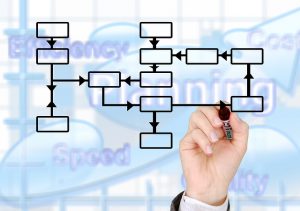Planning is an important management function because it helps managers prepare for the short term and long term challenges and opportunities that a business faces every day. Planning plays a crucial part in creating a business plan and strategic plan in that it reinforces a company’s mission, visions, and goals that are used to develop and implement strategy, competitive advantage, and achieve effectiveness and efficiency in how a business operates.
What Planning Means
 Planning is a combination of analysis and outlining a plan of action. Planning is what you want to do to achieve some goal or objective to help better manage a business. The purpose of planning is to plan what direction the business is headed, what decisions need to be made, how to be better than competitors in the same industry and business, and how to eliminate wastefulness and optimize current operations. Since plans address a huge variety of business objectives, they tend to be very diverse themselves, but all good plans have a few core components:
Planning is a combination of analysis and outlining a plan of action. Planning is what you want to do to achieve some goal or objective to help better manage a business. The purpose of planning is to plan what direction the business is headed, what decisions need to be made, how to be better than competitors in the same industry and business, and how to eliminate wastefulness and optimize current operations. Since plans address a huge variety of business objectives, they tend to be very diverse themselves, but all good plans have a few core components:
Goals and objectives
What the organization wants to achieve; they can range from very broad (the big picture, the overall strategy, the long-run) to very specific (in the moment, tactics, the short term). Remember, it is the small steps (objectives) that help a business reach their big steps (goals).
Analysis of the External Environment
What is outside of the organization’s control in the form of evolving trends, new technologies, additional laws, emerging competition, unusual events, etc. No one can truly predict what will happen tomorrow, only what could happen. So, in the event something changes (good or bad), a business can be better prepared for it.
Analysis of the The Internal Environment
Good plans are not created in a vacuum: they take into careful consideration the mood and corporate culture in which they are hatched. This means managers need some level of awareness of what is going on in human resources, the accounting department, the legal department, marketing and sales, logistics, maintenance, and so forth. Such activities can create value for the organization, or they can be a source of great loss if not properly controlled.
Company Equity
What the company owns and what it has that creates value and wealth that indicates its financial position and the power it holds over the market and its competitors. Excellent planning tries to leverage all the tools a manager has at his or her disposal to best reach their goals.
Planning Scope
Different levels of an organization will make plans with a different scope. A plan’s scope means how big the plan is in relation to the company’s total operations. The higher up in an organization a manager is, the wider the scope their plans usually have. The major types of planning scopes are:
Strategic Planning
Strategic Planning is the very highest-level plans in an organization. These plans define what a company is and what it does, and should serve as the guiding philosophy for all of the managers at a company when setting goals and objectives. Strategic plans usually do not outline specifics, just a broad company direction. Strategic plans usually have a time horizon of several years.
Business Planning
A “Business Plan” defines some core goals, either of a business as a whole or a division of a business. The Business Plan takes the company’s vision and translates it into specific, obtainable goals, usually with defined time horizons on when they expect these goals can be accomplished. Business Plans are usually created as a collaboration of the top-level managers and much of the middle management. With smaller and younger companies, Strategic Planning and Business Planning is often merged – eliminating the Strategic Planning phase and skipping straight to a Business Plan (see below). Business Plans usually have a time horizon of just a year or two.
Operational Planning
Operational Planning means converting the goals outlined in the Business Plan into specific objectives with fairly short time horizons, and outlining to a team how to obtain those objectives. Operational planning focuses on defining the direction that the rank-and-file staff of a company should be working on day-to-day, and are usually created by the lowest level managers (with input from the middle management). Operational plans usually are project-based, so their time horizon depends on how big the project is that they want to tackle.
Entrepreneurial Planning
These are plans that deal with what can be created to grow the company and what can be introduced to consumers to add value. Entrepreneurial planning stages do not follow the same hierarchical structure as the other types of plans – entrepreneurial ideas are often generated throughout the company, and tend to move up and down through the management levels as the ideas are refined.
The Business Plan
 A “Business Plan” in this context is the core document of a small business – it merges many elements of both Strategic Planning and Business Planning together to present one clear vision of what a company is, what its goals are, and how it seeks to achieve them. A good business plan serves three functions: it provides direction to all levels of management as to where the company is heading (like a Strategic Plan), it provides guidance for what a company’s goals and missions are to the rank-and-file workers at a business, and it serves as a document to present to banks and other investors to show why a company will be profitable.
A “Business Plan” in this context is the core document of a small business – it merges many elements of both Strategic Planning and Business Planning together to present one clear vision of what a company is, what its goals are, and how it seeks to achieve them. A good business plan serves three functions: it provides direction to all levels of management as to where the company is heading (like a Strategic Plan), it provides guidance for what a company’s goals and missions are to the rank-and-file workers at a business, and it serves as a document to present to banks and other investors to show why a company will be profitable.
A business plan is made up of the following elements:
Executive Summary
The first thing that appears on your report and the last thing that is written once you have included all of the other necessary components of the business plan. The Executive Summary tries to condense all other parts of the business plan into one short glance.
Business Description
Defines what type of business you are going into and briefly goes over what you are offering consumers. The products or services that will be provided should also be specified here.
Mission Statement
A statement that has a set of goals that explains why the business exists, how it operates, and how it is unique compared to other businesses.
Vision Statement
A statement that inspires employees to perform at their best, and why customers remain loyal to an organization.
SWOT Analysis
 Reveals the possible strengths, weaknesses, opportunities, and threats that your company will encounter in internal and external business environment.
Reveals the possible strengths, weaknesses, opportunities, and threats that your company will encounter in internal and external business environment.
Objectives
The things that you want to achieve with your business.
Implementation
How the business plan will be executed such as the marketing, sale, distribution, promotion, etc.
Additional components can be added that explain in more detail the marketing strategy, marketing mix, competitive environment, competitive advantage, barriers to entry, and the external environment to cover any questions and concerns that may come up in those areas. Managers need to be aware that plans can change because of rapidly changing trends, new technology, political turmoil or economic downturn, poor customer demand and lack of customer support, surrounding events, and the additional costs than being associated with the business. These changes need to be mentioned or reflected in the business plan as they happen, making the business plan an evolving document.
Operational Planning
Strategic Planning is planning, but with strategy in front of it. The strategy part is studying and making decisions that will define the business and helps it maintain a competitive advantage. These are the plans that assess the identity of an organization, both to itself and its image to the rest of the world, and how to make better decisions when it comes to logistics, operations, marketing, selling, servicing, administering, investing, and producing a value that can be turned into cost-savings or profits. The goal of Operational Planning is to make a lasting and transformative impression inside and outside the organization that is practiced in a manager’s day-to-day activities.
Logistics Planning
 Planning and locating the procurement, distribution, and exchange of supplies and materials to reduce shipping time and decrease shipping costs.
Planning and locating the procurement, distribution, and exchange of supplies and materials to reduce shipping time and decrease shipping costs.
Operations Planning
Efficiently designing and delegating building layouts, the flow of operations, jobs, and job descriptions to lower production costs and incorporate new technology.
Marketing Plans
Effectively advertising and promoting the company by organizing and controlling various multimedia platforms such as direct mail, Facebook, Twitter, newspapers, etc.
Sales Plans
Planning and organizing sales methods given information from conducting surveys, studying current customers, researching current trends online, reading the news to know what changes will affect sales, etc.
Service Plans
Planning and controlling how workers respond to customers complaints and suggestions and evaluating the quality of services carried out and making continuous improvements.
Planning Methods and Techniques
The planning process demands awareness, perspective, and understanding. Realistically, the organization, those charged with running it, and those contributing resources need to implement methods and techniques to make the plan happen. Here are a few that can be used for the business plan and strategic planning:
Crowdsourcing
 Crowdsourced plans farm out most of the “heavy lifting” to a large number of people. Companies with strong cohesion of their low-level managers and workers can find great success when crowdsourcing business plans, because it gives all of the people involved a greater “stake” in helping define what company goals are attainable.
Crowdsourced plans farm out most of the “heavy lifting” to a large number of people. Companies with strong cohesion of their low-level managers and workers can find great success when crowdsourcing business plans, because it gives all of the people involved a greater “stake” in helping define what company goals are attainable.
Environmental Forecasting
Environmental forecasting means trying to predict what will happen next by looking at patterns and history of events, activities, trends, and the competition. This is a heavily data-driven type of planning, with emphasis on strong research and trend analysis.
SWOT Analysis
Looking at the strengths, weaknesses, opportunities, and threats of the internal and external environment. A SWOT analysis is a core component of most types of plans to help identify what can go right, and what can go wrong.
Competition Analysis
Knowing the barriers to entry, the power buyers have when it comes to quality and competitive forces, the power suppliers have on prices and quality, the threat of replacement substitutable products or services, and how strong competitive forces are among competitors. A competition analysis is essential for a company to know what they are up against in their field, and stay on top.
Value-Chain Analysis
A strategic analysis of primary activities (those that create value for the company) and support activities (those that add value to primary activities) to determine what can be improved, removed, or adjusted. A Value-Chain Analysis tries to look at a company as a whole to identify where the most value is being added to their products or services, and try to expand across the whole breadth.
Planning Relative to Other Management Functions
Management is maximizing benefits in everything that needs to be managed (logistics, human resources, operations, etc.). This involves a lot of planning on what to do, how to do it, where to do it, who does it, where will it go, who will it go to, how much, etc. However, planning is only one of the four major functions of management, the other three being organizing, leading, and controlling. These other three functions all require planning to be implemented expediently, efficiently, and effectively in that, all need planning to lay the groundwork before a management action or response is engaged.
 For instance, when it comes to organizing in the logistics department, the manager plans the structure of when shipments will be made, at what times, how long the shipments should be, at what facilities they should be distributed to reduce shipping costs. The manager also needs to plan how much supplies will be allocated to each factory, how much each factory will produce, how much of that product will be shipped to facilities, and where should they be distributed. The manager leads in the structure and allocation of what happens in the logistics department by planning how to get workers to do what is asked and expected of them so that the work process and item production are operating at the highest level. However, when problems arise the manager must control the situation by planning how to solve the problem and how to prevent it from happening again. Planning is in everywhere and everything the manager does.
For instance, when it comes to organizing in the logistics department, the manager plans the structure of when shipments will be made, at what times, how long the shipments should be, at what facilities they should be distributed to reduce shipping costs. The manager also needs to plan how much supplies will be allocated to each factory, how much each factory will produce, how much of that product will be shipped to facilities, and where should they be distributed. The manager leads in the structure and allocation of what happens in the logistics department by planning how to get workers to do what is asked and expected of them so that the work process and item production are operating at the highest level. However, when problems arise the manager must control the situation by planning how to solve the problem and how to prevent it from happening again. Planning is in everywhere and everything the manager does.
The importance of planning can be expanded to other areas and departments of a business because time really is money. Every second, minute, hour, day, month, and year spent on planning can make a lot of difference to how simplifying the production flow can minimize and decrease expenses, how quality can be improved and be used to demand higher prices, and how the freeing-up of resources can be used to develop new products and services to increase profits.
Strong plans are the core of a business – everything else is built from there! This lesson is part of the PersonalFinanceLab curriculum library. Schools with a PersonalFinanceLab.com site license can get this lesson, plus our full library of 300 others, along with our budgeting game, stock game, and automatically-graded assessments for their classroom - complete with LMS integration and rostering support!

Get PersonalFinanceLab
[qsm quiz=129]
